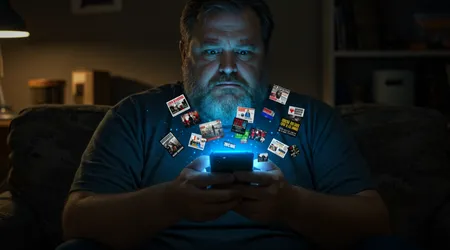Doomscrolling: Why We Can’t Stop Consuming Bad News

Doomscrolling the compulsive habit of endlessly scrolling through grim news has become a hallmark of our digital age.
Anúncios
In 2025, as social media platforms evolve and global uncertainties persist, this behavior reflects a deeper psychological tug-of-war between curiosity and distress.
Why do we, despite knowing better, dive headfirst into a sea of unsettling headlines?
This article explores the psychological and social drivers behind doomscrolling, its impact on mental health, and strategies to break free, all while navigating the complex interplay of human behavior and modern technology.
The allure of bad news isn’t new, but the digital era amplifies it. From climate crises to political upheavals, negative stories dominate our feeds, pulling us in with an almost magnetic force.
Anúncios
A 2020 NPR report highlighted doomscrolling as a “vicious cycle of negativity” that fuels anxiety, a sentiment that remains strikingly relevant today.
Our brains, wired for survival, crave information about threats, yet the constant exposure can erode our well-being. This piece unpacks why we’re hooked, how it shapes us, and what we can do to regain control.
The Psychology Behind Doomscrolling
Our brains are hardwired to prioritize danger. Evolutionary psychology suggests we’re drawn to threats to survive like spotting a predator in the wild.
Today, doomscrolling swaps lions for alarming headlines, triggering the same alertness. The amygdala, our brain’s fear center, lights up, urging us to keep scrolling for more.
This isn’t just instinct; it’s chemistry. Dopamine spikes when we encounter new information, even if it’s grim. Social media’s endless scroll exploits this, making doomscrolling a habit.
Harvard research shows it can shrink gray matter, linking it to anxiety. We’re trapped in a loop of seeking and regretting.
++ Human Behavior During Natural Disasters
Consider Jane, a fictional office worker who spends evenings doomscrolling climate disaster reports. Her curiosity starts innocently but spirals into dread.
This cycle mirrors how our brains chase closure, yet bad news rarely offers it, leaving us stuck in a loop of unease.
The negativity bias plays a key role. Humans focus more on threats than positives think of a newsfeed as a digital jungle.
A single alarming post about economic collapse overshadows ten stories of hope. This bias keeps us glued to doomscrolling, even when we know it’s draining.

The Role of Social Media Algorithms
Algorithms are the puppet masters of doomscrolling. Platforms like X prioritize engagement, and fear drives clicks.
Sensational headlines war, scandals, disasters eep us hooked. In 2025, AI-driven feeds tailor content to our fears, amplifying distress.
Think of algorithms as a chef serving spicy dishes because you tasted one. They learn you linger on bad news, so they serve more.
Also read: The Fascinating Psychology of Déjà Vu
A 2025 Semrush study found AI search visitors are 4.4 times more valuable than organic ones, showing platforms’ profit motive.
Take Alex, a student who follows global politics on X. One post about unrest leads to a flood of similar stories, curated to keep him scrolling. His feed becomes an echo chamber of gloom, designed to maximize time spent online.
This isn’t accidental. Platforms thrive on attention, and doomscrolling delivers.
Read more: The Milgram Experiment: How Far Will Obedience Go?
The more we engage, the more data they collect, refining algorithms to trap us further. It’s a business model built on our psychological vulnerabilities.
The Mental Health Toll
Endless exposure to bad news isn’t benign. Doomscrolling spikes cortisol, the stress hormone, disrupting sleep and focus. Chronic stress from this habit can mimic symptoms of anxiety disorders, leaving us frazzled.
A 2020 study linked doomscrolling to “popcorn brain,” a state of scattered attention from constant digital stimulation.
Over time, this rewires neural pathways, making calm focus harder. We become addicted to the chaos, craving the next hit of bad news.
Imagine Sarah, a teacher who scrolls X late at night. She feels drained yet can’t stop checking updates on global conflicts. Her mood sours, and her productivity dips, reflecting the toll on mental clarity.
The paradox is cruel: we seek control through information, but doomscrolling breeds helplessness.
Each story piles on dread, eroding our sense of agency. It’s like drinking saltwater to quench thirst temporary relief, lasting harm.
| Effect | Description | Source |
|---|---|---|
| Increased Anxiety | Chronic exposure to negative news elevates stress levels | NPR, 2020 |
| Popcorn Brain | Scattered attention from digital overload | Harvard, 2025 |
| Reduced Gray Matter | Linked to prolonged doomscrolling exposure | Harvard, 2025 |
| Sleep Disruption | Cortisol spikes impair restful sleep | General psychology |
Breaking the Doomscrolling Cycle
Breaking free from doomscrolling starts with awareness. Recognize when you’re spiraling set time limits for news consumption. Apps like Freedom can block distracting platforms, giving your brain a breather.
Curate your feed intentionally. Follow accounts that balance news with positivity, like science breakthroughs or community wins. This dilutes the algorithm’s grip, offering a healthier digital diet.
Try the “news diet” analogy: treat bad news like junk food. Indulge sparingly, and pair it with nourishing content. Schedule specific times to check updates, avoiding late-night scrolls that disrupt sleep.
Mindfulness helps, too. Meditation apps like Headspace can ground you, reducing the urge to scroll. Replace doomscrolling with activities like journaling or reading fiction to reset your focus.
Engage offline. Volunteer or join a local group to counter feelings of helplessness. Taking action, even small, shifts your mindset from passive consumer to active participant in change.
The Bigger Picture: Society and Doomscrolling

Why does bad news dominate? Media thrives on sensationalism fear sells. In 2025, global challenges like climate change and political polarization amplify this, feeding doomscrolling culture. Outrage travels faster than hope.
Socially, we’re drawn to shared distress. Scrolling bad news feels like joining a collective lament, a warped sense of community. Yet, it isolates us, replacing real connection with digital dread.
Consider a town hall meeting versus X. In person, people debate and bond; online, doomscrolling fuels division.
Algorithms amplify polarizing voices, making consensus feel impossible. Are we connecting or just commiserating?
This cycle reflects a broader shift. As AI search grows Semrush predicts it’ll surpass traditional search by 2028 our information habits evolve. We risk becoming passive consumers, shaped by algorithms rather than agency.
But there’s hope. Communities on X share tips to combat doomscrolling, like digital detoxes or curated feeds. These grassroots efforts show we can reclaim control, fostering a healthier digital culture.
FAQs About Doomscrolling
What is doomscrolling, and why is it harmful?
It’s the compulsive scrolling of negative news, increasing stress and anxiety. It disrupts sleep and focus, as Harvard research shows.
How can I stop doomscrolling?
Set time limits, curate positive feeds, and practice mindfulness. Replace scrolling with offline activities like volunteering to regain control.
